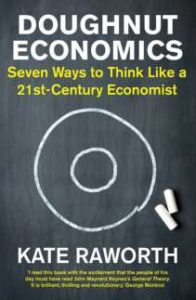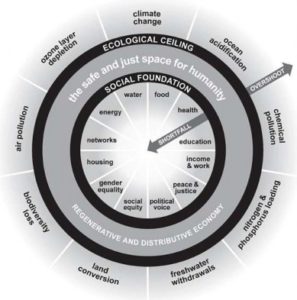Kate Raworth on economics for the 21st century – Editor
The following seven observations about the operation of modern economies and suggestions for action appear in Kate Raworth’s well known book Doughnut Economics [see Lars Syll blog,1]:
 1. Change the goal: from GDP growth to the Doughnut
1. Change the goal: from GDP growth to the Doughnut
- For over half a century, economists have fixated on GDP as the first measure of economic progress, but GDP is a false goal waiting to beousted. The 21st century calls for a far more ambitious and global economic goal: meeting the needs of all within the means of the planet. Draw that goal on the page and – odd though it sounds – it comes out looking like a doughnut …
-
2. See the big picture: from self- contained market to embedded economy
Exactly 70 years ago in April 1947, an ambitious band of economists crafted a neoliberal story of the economy and, since Thatcher and Reagan came to power in the 1980s, it has dominated the international stage. Its narrative about the efficiency of the market, the incompetence of the state, the domest- icity of the household and the tragedy of the commons, has helped to push many societies towards social and ecological collapse. It’s time to write a new economic story fit for this century – one that sees the economy’s dependence upon society and the living world …
-
3. Nurture human nature: from rational economic man to social adaptable humans
The character at the heart of 20th century economics — ‘rational economic man’ — presents a pitiful portrait of humanity: he stands alone, with money in his hand, a calculator in his head, ego in his heart, and nature at his feet. Worse, when we are told that he is like us, we actually start to become more
like him, to the detriment of communities and the planet. But human nature is far richer than this, as the emerging sketches of our new self-portrait reveal: we are reciprocating, interdependent, approximating people deeply embedded within the living world …
-
4. Get savvy with systems: from mechanical equilibrium to dynamic complexity
Economics has long suffered from physics envy: awed by the genius of Isaac Newton and his insights into the physical laws of motion, 19th century economists became fixated on discov- ering economic laws of motion. But these simply don’t exist: they are mere models, just like the theory of market equilibrium which blinded economists to the looming financial crash of 2008. That’s why 21st-century economists embrace complexity and evolutionary thinking instead …
-
5. Design to distribute: from ‘growth will even it up again’ to distributive by design
In the 20th century economic theory whispered a powerful message when it comes to inequality: it has to get worse before it can get better, and growth will eventually even things up. But extreme inequality, as it turns out, is not an economic law or necessity: it is a design failure. Twenty-first century economists recognize that there are many ways to design economies to be far more distributive of value among those who help to generate it …
-
6. Create to regenerate: from ‘growth will clean it up again’ to regenerative by design
Economic theory has long portrayed a clean environment as a luxury good, affordable only for the well-off — a view that says that pollution has to increase
before it can decline, and (guess what), growth will eventually clean it up. But as with inequality there is no such economic law: environmental degradation is the result of degenerative industrial design …. This century needs economic thinking that unleashes regenerative design in order to create a circular – not linear – economy, and to restore humans as full participants in Earth’s cyclical processes of life.
-
7. Be agnostic about growth: from growth-addicted to growth-agnostic
T o the alarm of governments and financiers, forecasts for GDP growth in many high-income countries are flatlining, opening up a crisis in growth- based economics. Mainstream economics views endless GDP growth as a must, but nothing in nature grows for- ever, and the economic attempt to buck that trend is raising tough quest-ions in high-income but low-growth countries. That’s because today we have economies that need to grow, whether or not they make us thrive. What we need are economies that make us thrive, whether or not they grow. ”
o the alarm of governments and financiers, forecasts for GDP growth in many high-income countries are flatlining, opening up a crisis in growth- based economics. Mainstream economics views endless GDP growth as a must, but nothing in nature grows for- ever, and the economic attempt to buck that trend is raising tough quest-ions in high-income but low-growth countries. That’s because today we have economies that need to grow, whether or not they make us thrive. What we need are economies that make us thrive, whether or not they grow. ”
1. Source:
Lars Syll, Real World Econ Rev, 13 June 18 https://rwer.wordpress.com/2018/06/13/economics-for-the-21st-century/
The doughnut depicts a social foundation of well-being that nobody should fall below, and an ecological ceiling that should not be exceeded. Between the two lies a safe and just space.



























